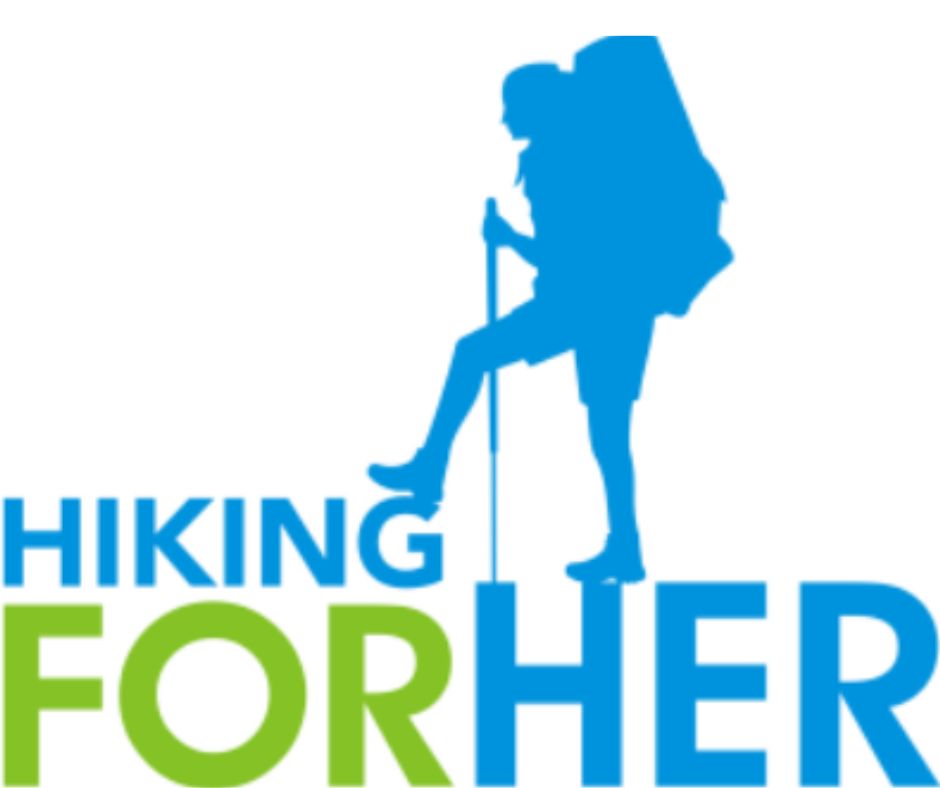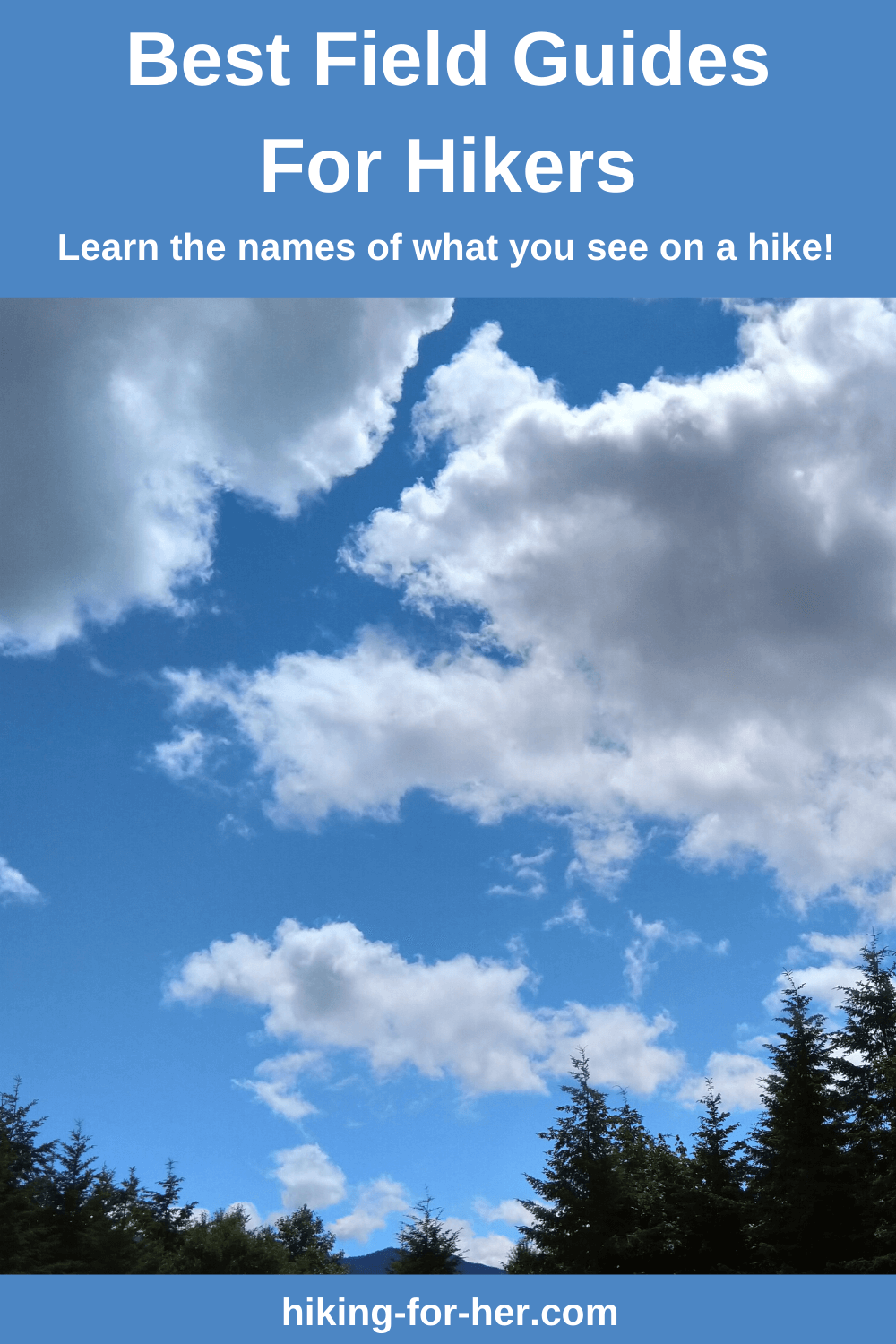Best Hiking Field Guides:
Do You Need Them?
By Diane Spicer
So why carry hiking field guides?
Because sooner or later, you or a trail companion are going to ask the pivotal question:
"What is that??"

Follow up question: "Is it alive?"
And you're gonna wish that you had a hiking field guide in your backpack.
Adopt the scout motto: Be Prepared
Nothing says "prepared" more than whipping out a hiking field guide to make a positive I.D. on that hot marmot in a tree (highly unusual behavior, as you'll read in your guide).
Or putting a name to that tiny bird with bright blue feathers that just flew into the tree above your head.
And can you savor the satisfaction of discovering the name of the clump of wild flowers that you just noticed beside the trail?
I've spent hours in just such an activity!
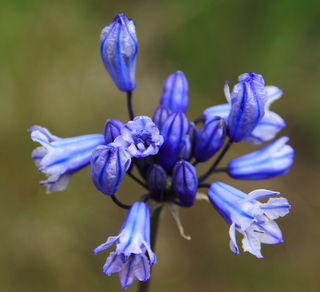 Appreciate the complexity and beauty of flowers with your field guide in hand
Appreciate the complexity and beauty of flowers with your field guide in handAnd of course, knowing how to avoid trouble in the form of venomous animals or poisonous plants is a GREAT outdoor skill to possess.
I highly recommend it!
Which field guides to
use regularly as a hiker?
So which hiking field guides are worth the weight in your pack, or the space on your book shelf?
I've thought a lot about that over the decades of gathering dust on my boots (not because they were sitting on the shelf along with my books, mind you!).
And I'd like to share my Top Ten Hiking Field Guides, the best ones I feel are worth the weight or the time & money investment for any serious hiker.
Hopefully, they will become your favorites, too.
Hiking For Her's top ten
hiking field guides,
in no particular order
Don't assume that I'm listing the guides in the order of their importance.
Every hiker has unique interests. So pick and choose the ones that speak to you.
And be on the lookout for the perfect gift for your hiking buddy as you go through my list.
Field Guide #1:
Birds Of (fill in your state here)
Let me illustrate this hiking field guide with my home state, Washington.
I love my Birds Of Washington field guide because it's:
- small
- lightweight
- illustrated with fantastic color photos
- reasonably weather resistant
The book comes with a small outline of the state map on each page, indicating migratory, summer and winter ranges.
You can tell at a glance if it's possible for this bird to be in your backyard or sitting above your favorite hiking trail.
As if that's not enough, Stan Tekiela organized the information by the predominant color of the bird, so amateurs like me can go straight to the relevant page.
- My husband and I keep this book handy on the dining room table near a large window (when it's not in my pack) for identifying unusual bird visitors to our suet and seed feeders.
- Stan has helped us make a positive i.d. on lots of migrating song birds right in the backyard.
- And on the trail, it's been a great help in sorting out ducks, woodpeckers and raptors.
Can you tell I'm enthusiastic about this book?? You've got to have one in your collection!
But wait! There's more!
He does more than just bird books by state - how about birds of prey?
He offers recordings of bird sounds, too, which would be splendid if you're an auditory learner.
Birds not your thing? He's got you covered: field guides to plants and flowers, family guides to nature...he's a force of nature himself!
Birds of Washington Field Guide
Field Guide #2:
Audubon Regional Field Guides
The Audubon name carries a lot of weight for naturalists.
I have a general field guide to the Pacific Northwest (there's one available for your region, too) which I dip into regularly.
- It covers birds, animals, trees, wildflowers, insects, weather, terrain....so it's not as light as I'd like it to be.
But, Hey!
It answers all of my questions on the trail, so I commit to carrying it to scratch my curiosity itch.
And you can buy specific guides, too: just wildflowers, just trees.
Currently, I'm obsessed with ferns because my husband collects fern spores and hand raises all of the native ferns in our region.
No kidding!
Sometimes I leave my Audubon guide collection in the car for handy reference.
- I write down my questions and observations during my trail time.
- Then I use the "Audubon Fount of Knowledge" as soon as I'm back at the trail head.
This seems to sharpen my observation skills, knowing that I have to rely upon my memory and written notes to find the answers.
Of course, taking a photo works, too!
You will need to buy the guides specific to your area, if you want 100% reliable information.
And be forewarned: visiting this website will suck hours out of your schedule - there are so many Audubon books to drool over! Here's an example:
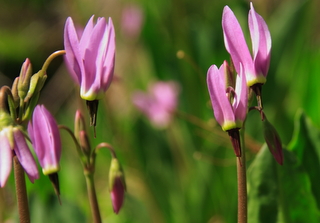 Shooting stars burst forth on boggy ground, a good clue to avoid that terrain
Shooting stars burst forth on boggy ground, a good clue to avoid that terrainTip:
Buy a used copy.
It's going to see some rough use in the field anyway!
Field Guide #3:
A Field Guide to Mammal Tracking in North America
by James Halfpenny
This is definitely a
book to throw into your pack, if you're curious about the unseen wild
mammals keeping you company in the great outdoors.
I love its lightweight but data-packed pages, and rely on its careful discussion of behavioral clues, gaits and footprint sizes.
There's even a chapter on scatology (the study of poop)!
What's not to love?
A Field Guide to Mammal Tracking in North America
Field Guide #4:
Animal Skulls: A Guide to North American Species
by Mark Elbroch
This is my current favorite hiking field guide, although it doesn't hike with me.
It's too big to bring into the field, so I bring my "finds" back to my desk and let Mark help me figure out whose skull I've found.
Elbroch includes photos, diagrams, and tables to give you all of the data you need for a positive identification.
This isn't technically a field guide - too big, too detail rich, too much into bones at the exclusion of everything else.
It:
- names each skull bone (a thrill for amateur anatomists)
- uses anatomical terminology (dorsal & ventral for back & front, for example)
- and it really gets into the nitty gritty of bony landmarks (another thrill for geeking out on bones)
But for me, trained in anatomy and fascinated by the adventure of mammalian comparative anatomy, it's a treasure.
Maybe you'll treasure it, too!
And before you decide he's not the author for you, consider the fact that he also writes ddetailed books about mammal and birds tracks and signs.
Field Guide #5:
Stokes Nature Guides
by Donald and Lillian Stokes
These are worth a look if you're building a field guide library from scratch.
The Stokes specialize in birds, but they have a few books in their collection on mammal tracking, amphibians & reptiles, as well as bird and mammal behavior.
- There's one I really like on Nature in Winter, touching upon winter tree adaptations, snow crystals, and other topics you don't often see in a general field guide.
Their books are well written and beautifully illustrated - well worth a place on your hiking field guide shelf & in your pack.
Field Guide #6:
Peterson's Field Guides
This is a good place to start with young hikers, or those who might be overwhelmed with technical details.
It's where I started many decades ago!
Name your topic, it's available!
- Birds
- Plants (even edible & medicinal ones)
- Mammals
- Reptiles & amphibians
- Venomous animals & poisonous plants
- Fishes
- Insects
- Earth & sky
- Seashore
- Rocks and minerals
- Ecology
Wow!
You're going to need a few months off just to dip into this treasure trove.
And here's a fun fact: These books are timeless.
On my hiking field guide bookshelf, I have a 1986 copy of "First Guide to Wildflowers", which I still use to cross reference more updated and specific hiking field guides.
I love the way it's laid out: organized by color of flower, backed up with detailed, useful drawings.
Let these field guides amaze you with their wealth of information, written in non-technical language and well illustrated.
Tip:
And they make great gifts for kids just whetting an appetite for the outdoors but with room to expand a growing knowledge base.
Start with the scary stuff: venomous critters and creepy crawlies.
As I mentioned, I've had mine for awhile! Here it is:
Field Guide #7:
Field Guide to the Cascades & Olympics
by Stephen R. Whitney & Rob Sandelin
OK, so this one is very regional, with its focus on the Pacific Northwest.
But it's my hope that you will plan a hiking adventure to my favorite U.S. region someday soon, and you'll definitely want this guide in your backpack when you arrive.
It has just enough detail to satisfy your curiosity.
The photos will whet your appetite for some Washington State hiking, and the color illustrations will be very useful once you get here.
And if the Pacific NW is your home, use this guide to familiarize yourself, or introduce young hikers, to our gorgeous backyard.
Field Guide #8:
Tom Brown's Field Guide to Nature Observation
and Tracking
Some folks don't like Tom Brown's somewhat mystical approach to the outdoors, while others question his credibility.
Me?
I learn what I can from every author/mentor, and Tom is definitely knowledgeable and passionate about the outdoors.
He has many, many books on outdoor skills, and this happens to be a favorite of mine.
Why?
Because it blends awareness of nature with factual skills.
If you want just the facts on tracking, stick with the book recommendation in #3 above.
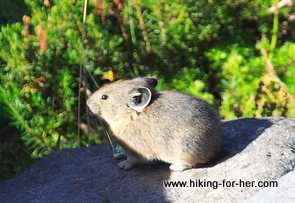 A tiny pika can emit an ear splitting EEEP, guaranteed to get your attention on a hike
A tiny pika can emit an ear splitting EEEP, guaranteed to get your attention on a hike
Field Guide #9:
Stars & Planets
by Ian Ridpath (Eyewitness Handbooks)
We modern humans don't spend enough time under stars and moon any more.
Do you miss the moon?
When I hiked for a week in New Mexico, I was stunned at the immensity and brilliance of the dark night sky.
That's when I remembered that I had purchased this guide a long time ago, when I was living under the dark night time skies of upper northern Michigan (the U.P.).
It ended up on my bookshelf, behind lots of other hiking field guides, because I don't have access to unadulterated night skies in the cloudy Pacific NW.
But if you have regular access to darkness, or are planning a backpacking trip to such a wonderful place, consider adding this visual guide to stars to your collection.
It provides very detailed sky charts, monthly sky guides, and colored photos.
Very fascinating!
So is the idea of night hiking.
Ever tried it? Get started with the idea here.
I highly recommend it for these reasons:
- Use your night vision (no flashlight or headlamp!) on a well maintained trail or even across a cleared area, to get the hang of using your peripheral vision.
- It will bring up all sorts of hidden fears to conquer, and just might lead you into a new hiking realm!
- You can figure out where you are by using the night sky, if you've studied this field guide!
Field Guide #10:
Pocket Naturalist Guide
laminated fold-outs
Still with me? Great news!
Here's the handiest idea yet for hiking field guides.
These convenient foldable cards are a good idea if you're just starting out and don't want to commit to books just yet.
Or if you have kids, and don't want to put expensive hiking field guides into muddy hands.
Or if weight in your backpack is a serious issue.
I have several of these tucked into an inner pocket of my pack: animal tracks, wildlife, wildflowers, skulls & bones.
Just be sure to check for guides to your region/state if you don't want general overview information.
The beauty of these hiking field guides?
Let me count the ways:
- lightweight
- weather proof
- indestructible
- just the facts
- well illustrated
- crammed with helpful factoids to make you want more information
That's when you know you're ready for the guide books listed above!
Here's one of my go-to guides:
Bonus round
You know me. I love to share the best hiking tips!
I couldn't stop at just 10, I had to add my newest favorite:
Bird Feathers: A Guide to North American Species by S. David Scott & Casey McFarland.
I'll share a little quirk I have as a hiker to explain why this book thrills me.
- I have always stopped to pick up bird feathers, ever since childhood.
And I'm currently obsessed with identifying birds, based upon the feathers I stumble across on my adventures.
This book is beautiful and thorough, and has answered so many of my bird feather questions.
The photos alone will make you appreciate Nature on a deeper level.
Hiking field guides are like
a college education in the outdoors!
I hope you have a chance to browse through some of these recommended hiking field guides.
Why just hike along a trail when you can give yourself a wealth of information about the plants and animals, rocks and minerals that surround you?
Just in case you're hungering for more hiking resources, here's a comprehensive list of available guides from Acorn Naturalists.
And don't spend a lot of money building up your hiking field guide library.
- Used book stores, libraries, community book sales and virtual bookstores can give you a taste of the abundance of knowledge available to you, before you commit to purchasing them.
- If you a Kindle hiker (see tips here), some of these hiking field guides are available free if you're a Prime member.
But I don't think you can go wrong with my picks.
They've taught me all of what I know about the living things around me, and the stars above me, as I hike.
Please send me your feedback and suggestions - life long love of learning makes the hiking field guide bookshelves groan, right?
Ah! But it satisfies our curiosity ;)
And hiking as a curious cat is way more fun than trudging along blindly, I'm sure you will agree.
Home page > Best Hiking Tips >
Best Hiking Field Guides
|
I get emails all the time about what I wear, eat, carry and love to use on the trail. That's
why I provide affiliate links to you: the best gear that I use myself and have seen used by other hikers is instantly
available for your consideration, and the gear company sends a few
pennies per dollar to this reader-supported hiking website. There is no added cost to you! Everyone ends up a winner: Great gear for you, strong gear companies, and more free hiking tips for everyone. Thanks very much for your support. It's warmly and sincerely appreciated. It also helps send these hiking tips to all your virtual trail buddies around the globe. |
 |
